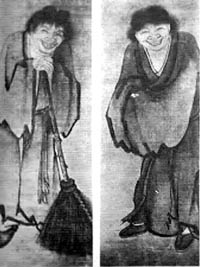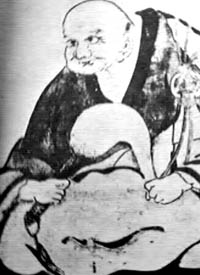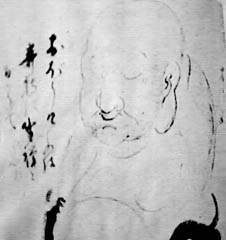 | |||||
|
|
Zen art, as Conrad Hyers puts it, shows us a "collapse of the sublime." One of the functions of comedy, bringing everything back to earth, is at the center of Zen art's focus. The divine becomes more human in Zen art, as it was believed that Buddha-nature could be found in all human beings and all things. In contrast to art of the Mahayana Buddhists, Zen art is radically different, with its focus on the earthly, common person. Buddhas are now approachable, no longer sitting on thrones of fanciful and regal glory. Zen style is not extravagant or highly adorned like Mahayanist art, representing its refusal to indulge in earthly pleasures or to become too attached. Significance is attributed to even the most lowly of things; Hakuin once sketched a portrait of a Zen priest urinating! Sengai, in his 'The One Hundred Days Teaching of the Dharma,' depicts a monk leaning over to pass gas. Zen art is therefore an inversion of previous Mahayana art, just as humor is an inversion of what one would expect.
The portraits of these two laughing monks by Yen-hui shows a comic hilarity, yet we do not see anything vulgar. Their laughter seems like they are witnessing a sense of liberation, joy, and freedom, like they know something that the viewer does not. The two monks appear to invite the viewer in to join them, with their hand gestures. Kanzan and Jittoku are famous for their mad, outrageous laughter, yet in this laughter, they are free.
Hakuin, a prominent figure in Rinzai Zen, portrays himself in his self portrait as a bald, fat, cross-eyed and hunch-backed old man. He is not an idealized "enlightened one," but looks rather clown-like. One story told by Hakuin in his Orategama describes how he believed to have had his first satori (enlightenment) at the young age of twenty-four. He burst out in a sense of pride, and tells how his "arrogance surged forward like the tide." Confident in having attained enlightenment, Hakuin goes to tell his master, Shoju. Shoju was clearly not impressed, and twists Hakuin's nose, saying "You poor hole-dwelling devil! Do you think somehow that you have sufficient understanding?" Years later after this rather comic incident, in painting his self-portrait, Hakuin's pride and arrogance are lost. A poem written above the portrait is extremely revealing, demonstrating the Buddha sees through the pride and arrogance of the desiring self: "He crushes the silent-illumination heretics of today, and massacres the heterodox blind monks of this generation."
Hakuin also painted another fascinating portrait of himself, but this time in the form of Hotei (or Pu-tai in Chinese). Hotei can be thought of as a sort of Oriental Santa Claus; he was a merry fellow who would travel from village to village, playing with children and brining them gifts in his sack (his name literally means 'large linen sack' in Chinese). With an enormous belly, and a smirking face, Hotei is a common theme in Zen art. He is the stereotypical "clown-figure" that Westerners associate as the Laughing Buddha in curio shops. This is not to say that Zen believes in carefree abandon and just going out to 'have a good time' without any limits, but laughter must be kept in tune with seriousness - a duality, and yet a unity, between laughter and seriousness is present in Zen. In this portrait, Hakuin/Hotei is in a serious, meditating position, yet he is smirking, making him look like he is about to burst out laughing; we see this dualism unified within this portrait. Hotei refused the title of the Zen master, as he found the freedom and wisdom in the laughter and joy of small children. For instance, when someone would come up to Hotei asking for guidance or asking him to return to the temple, Hotei would reply, "Give me a penny" as he extended his arm. This playful spontaneity is like that of a child. It is also significant that it is thought that the avatar of Maitreya, the Buddha to come, will be manifested in the form of Hotei. Thus, the convergence between spirituality and the comic, roaring laughter of enlightenment in Zen will be complete. This painting does not seem to be complete in the eyes of a Western observer; the lines are quickly sketched, and the canvas is quite empty. However, this ambiguity and indefiniteness is a key to Zen art. It is ambiguous, like the double-meanings of puns, just as how reality cannot be pinned down or analyzed.
|
||||
Jason Anderson Japanese 92 Final Project Professor Hare | |||||
 The
Portraits of Kanzan and Jittoku
The
Portraits of Kanzan and Jittoku Hakuin's Self Portrait
Hakuin's Self Portrait Hakuin's Self Portrait in the Image of Hotei
Hakuin's Self Portrait in the Image of Hotei